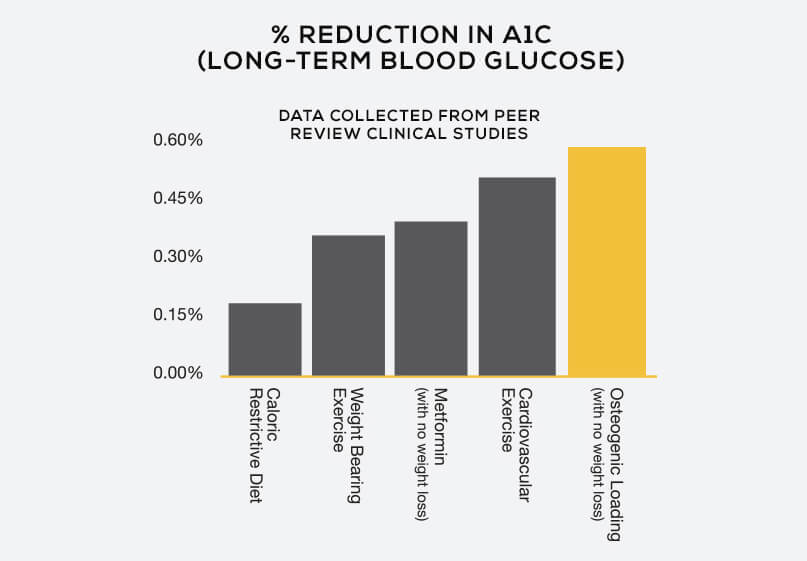skeletal strength for diabetes
OSTEOSTRONG CAN HELP WITH TYPE II DIABETES
There are multiple, well-proven and safe approaches to treating type II diabetes and metabolic dysfunction. Fortunately, these different approaches can be used individually, or in conjunction with one another. When viewed as single therapies however, it is OsteoStrong that performs the best compared to the other standards of care in the reduction of HbA1c (long term blood glucose measures).

STRONG BONES FOR A STRONGER DEFENSE AGAINST DIABETES
Diabetes is a chronic medical condition, and it affects millions of people all over the world. A person would develop diabetes when their body becomes unable to regulate its blood sugar levels, resulting in higher blood sugar. Having this condition would mean that your body would gradually cause serious health problems, including nerve damage, heart disease, and bone health problems.
Furthermore, there are multiple, well-proven, and safe approaches to treating type II diabetes and metabolic dysfunction. Fortunately, these different approaches can be used individually, or in conjunction with one another. When viewed as a single therapy, however, it is OsteoStrong that performs the best compared to the other standards of care in the reduction of HbA1c (long-term blood glucose measures).
At OsteoStrong’s health and wellness center, we specialize in helping people with diabetes maintain their bone health. Our facilities are staffed by trained medical professionals who are knowledgeable about the latest research and treatments for bone health problems. They can help people with diabetes manage their bone health by providing a variety of services, including:
People with diabetes need to follow a healthy diet to manage their blood sugar levels. However, some dietary choices can also affect bone health. OsteoStrong can provide nutritional counseling to help people with diabetes make choices that promote bone health.
Doing regular exercise is important for maintaining bone health. OsteoStrong can provide exercise programs that are tailored to the needs of people with diabetes. These programs may include weight-bearing exercises, which are particularly beneficial for bone health.
Bone density scan and testing is a non-invasive test that measures the strength of bones. People with diabetes are at an increased risk of developing osteoporosis, but OsteoStrong help identify the early signs of osteoporosis and allows doctors to develop a treatment plan to prevent further bone loss.
Some medications used to manage diabetes can affect bone health. Bone health facilities can provide medication management services to ensure that people with diabetes are taking medications that promote bone health.
DON’T WAIT! GET BACK INTO SHAPE TODAY!
With OsteoStrong’s wellness center at Lake Forest, our facilities can be an invaluable resource for people with diabetes. By providing a range of services to promote bone health, we can help people with diabetes maintain their bone health and reduce their risk of fractures and other bone health problems. If you have diabetes, consider visiting OsteoStrong to take advantage of the services they offer and take control of your bone health.
Don’t wait until it’s too late – start working on your bone health today to reduce your risk of fractures and other bone health problems.
TYPE II DIABETES STATISTICS

WHO TYPE II DIABETES AFFECTSture Item 1
Type II diabetes (T2D) and pre-diabetes, also known as metabolic disease, affects nearly 100 million Americans (1 in 3 people).

COSTS OF TREATMENT
Treatment costs exceed $322 billion per year.

HEALTHCARE & METABOLIC DISEASE
20% of all healthcare dollars are spent on metabolic disease.
For More Information On Bone Health & Diabetes
Most estimates of diabetes in this report do not differentiate between type 1 and type 2 diabetes. However, because type 2 diabetes accounts for 90% to 95% of all diabetes cases, the data presented are likely to be more characteristic of type 2 diabetes.




